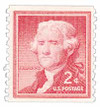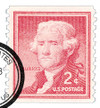
1954 Liberty Series Coil Stamps,2¢ Thomas Jefferson
# 1055 - 1954 Liberty Series Coil Stamps - 2¢ Thomas Jefferson
$0.35 - $15.95
U.S. #1055
2¢ Thomas Jefferson
Liberty Series Coil Stamp
2¢ Thomas Jefferson
Liberty Series Coil Stamp
Issue Date: October 22, 1954
City: St. Louis, MO
Printing Method: Rotary press dry printing
Perforations: 10 vertically
Color: Carmine rose
City: St. Louis, MO
Printing Method: Rotary press dry printing
Perforations: 10 vertically
Color: Carmine rose
The 2¢ Liberty Series coil stamp pictures Thomas Jefferson, the third President of the United States.
The Liberty Series
Issued to replace the 1938 Presidential series, this patriotic set of stamps honors guardians of freedom throughout U.S. history. Eighteenth Century America is represented by Revolutionary War heroes and statesmen such as Washington, Jefferson, Franklin, Hamilton, Henry, Jay, and Revere.
Leaders of the 19th century including Monroe, Lincoln, Lee, Harrison, and Susan B. Anthony make an appearance. The 20th century is represented by Teddy Roosevelt, Woodrow Wilson, and General Pershing.
The Liberty Series also features famous locations important to America’s democratic history, such as Bunker Hill, Independence Hall, and the Alamo.
“Wet” versus “Dry” Printing
The Bureau of Engraving and Printing began an experiment in 1954. In previous “wet” printings, the paper had a moisture content of 15 to 35 percent. In the experimental “dry” printings, the paper had a moisture content of 5 to 10 percent. This process required stiffer, thicker paper, special inks, and greater pressure to force the paper through the plates.
Stamps produced by dry printing can be distinguished by whiter paper and higher surface sheen. The stamps feel thicker and the designs are more pronounced than on wet printings. The experiment was a success, and all U.S. postage stamps have been printed by the dry method since the late 1950s.
The Presidency (1801-09)
and Later Years of Thomas Jefferson
and Later Years of Thomas Jefferson
America’s third President, Thomas Jefferson, believed in a small federal government. Expenditures were cut, the Army and Navy reduced, and payments were made on the national debt. He also believed appointment to federal jobs should be based on merit, and instituted this practice.
For some time, U.S. ships had been harassed by the Barbary pirates of North Africa. These pirates attacked ships in demand of protective tribute. In 1801, Tripoli began a war on U.S. shipping. Under Jefferson’s orders, the small U.S. Navy blockaded ports, bombarded fortresses, and earned a fierce reputation. In 1805, the U.S. and Tripoli signed a peace agreement.
One of the President’s greatest accomplishments was the 1803 Louisiana Purchase. For about $15 million, the U.S. nearly doubled its size and gained control of the Mississippi. Jefferson made the purchase despite doubts about its legality. In his words, he “stretched the Constitution till it cracked.” Jefferson secured a grant from Congress to finance the legendary Lewis and Clark Expedition. Lewis and Clark explored the headwaters of the Missouri River, and then crossed the Rockies and journeyed to the Pacific. This exploration greatly increased the knowledge of America’s West.
In 1803, war erupted between Britain and France. Jefferson was faced with the challenge of keeping America neutral as both nations issued warnings that even neutral ships trading with the enemy would be attacked. British ships began stopping American ships and capturing suspected British deserters. Unfortunately, many Americans were taken as well. In June 1807, the situation peaked when a British frigate attacked an American ship.
Jefferson knew the U.S. was not prepared for a war. So, with the 1807 Embargo Act, he attempted to close U.S. markets as an economic incentive to bring the nations to peace. The Embargo Act hurt the U.S. much more than the British or French. The embargo became very unpopular, as the American economy suffered and unemployment spread. Fourteen months later, Congress repealed the act and replaced it with the much-milder Non-Intercourse Act.
Jefferson followed the example set by George Washington and retired after two terms, at the age of 65. He named James Madison his choice as a successor, and Madison won by a large margin.
Jefferson retired to Monticello and pursued academic interests. He dedicated himself to creating the University of Virginia, and was involved in all aspects of the school’s creation, from drawing the plans for its buildings to hiring faculty. In March 1825, Jefferson had the pleasure of seeing the university open its doors. He died on the 50th anniversary of the Declaration of Independence, on July 4, 1826. He wrote the inscription for his grave’s marker, and insisted that no changes be made: “Here was buried Thomas Jefferson, Author of the Declaration of Independence, of the Statute of Virginia for religious freedom, & Father of the University of Virginia.” Jefferson ranked these accomplishments higher than being President of the United States.
U.S. #1055
2¢ Thomas Jefferson
Liberty Series Coil Stamp
2¢ Thomas Jefferson
Liberty Series Coil Stamp
Issue Date: October 22, 1954
City: St. Louis, MO
Printing Method: Rotary press dry printing
Perforations: 10 vertically
Color: Carmine rose
City: St. Louis, MO
Printing Method: Rotary press dry printing
Perforations: 10 vertically
Color: Carmine rose
The 2¢ Liberty Series coil stamp pictures Thomas Jefferson, the third President of the United States.
The Liberty Series
Issued to replace the 1938 Presidential series, this patriotic set of stamps honors guardians of freedom throughout U.S. history. Eighteenth Century America is represented by Revolutionary War heroes and statesmen such as Washington, Jefferson, Franklin, Hamilton, Henry, Jay, and Revere.
Leaders of the 19th century including Monroe, Lincoln, Lee, Harrison, and Susan B. Anthony make an appearance. The 20th century is represented by Teddy Roosevelt, Woodrow Wilson, and General Pershing.
The Liberty Series also features famous locations important to America’s democratic history, such as Bunker Hill, Independence Hall, and the Alamo.
“Wet” versus “Dry” Printing
The Bureau of Engraving and Printing began an experiment in 1954. In previous “wet” printings, the paper had a moisture content of 15 to 35 percent. In the experimental “dry” printings, the paper had a moisture content of 5 to 10 percent. This process required stiffer, thicker paper, special inks, and greater pressure to force the paper through the plates.
Stamps produced by dry printing can be distinguished by whiter paper and higher surface sheen. The stamps feel thicker and the designs are more pronounced than on wet printings. The experiment was a success, and all U.S. postage stamps have been printed by the dry method since the late 1950s.
The Presidency (1801-09)
and Later Years of Thomas Jefferson
and Later Years of Thomas Jefferson
America’s third President, Thomas Jefferson, believed in a small federal government. Expenditures were cut, the Army and Navy reduced, and payments were made on the national debt. He also believed appointment to federal jobs should be based on merit, and instituted this practice.
For some time, U.S. ships had been harassed by the Barbary pirates of North Africa. These pirates attacked ships in demand of protective tribute. In 1801, Tripoli began a war on U.S. shipping. Under Jefferson’s orders, the small U.S. Navy blockaded ports, bombarded fortresses, and earned a fierce reputation. In 1805, the U.S. and Tripoli signed a peace agreement.
One of the President’s greatest accomplishments was the 1803 Louisiana Purchase. For about $15 million, the U.S. nearly doubled its size and gained control of the Mississippi. Jefferson made the purchase despite doubts about its legality. In his words, he “stretched the Constitution till it cracked.” Jefferson secured a grant from Congress to finance the legendary Lewis and Clark Expedition. Lewis and Clark explored the headwaters of the Missouri River, and then crossed the Rockies and journeyed to the Pacific. This exploration greatly increased the knowledge of America’s West.
In 1803, war erupted between Britain and France. Jefferson was faced with the challenge of keeping America neutral as both nations issued warnings that even neutral ships trading with the enemy would be attacked. British ships began stopping American ships and capturing suspected British deserters. Unfortunately, many Americans were taken as well. In June 1807, the situation peaked when a British frigate attacked an American ship.
Jefferson knew the U.S. was not prepared for a war. So, with the 1807 Embargo Act, he attempted to close U.S. markets as an economic incentive to bring the nations to peace. The Embargo Act hurt the U.S. much more than the British or French. The embargo became very unpopular, as the American economy suffered and unemployment spread. Fourteen months later, Congress repealed the act and replaced it with the much-milder Non-Intercourse Act.
Jefferson followed the example set by George Washington and retired after two terms, at the age of 65. He named James Madison his choice as a successor, and Madison won by a large margin.
Jefferson retired to Monticello and pursued academic interests. He dedicated himself to creating the University of Virginia, and was involved in all aspects of the school’s creation, from drawing the plans for its buildings to hiring faculty. In March 1825, Jefferson had the pleasure of seeing the university open its doors. He died on the 50th anniversary of the Declaration of Independence, on July 4, 1826. He wrote the inscription for his grave’s marker, and insisted that no changes be made: “Here was buried Thomas Jefferson, Author of the Declaration of Independence, of the Statute of Virginia for religious freedom, & Father of the University of Virginia.” Jefferson ranked these accomplishments higher than being President of the United States.



















